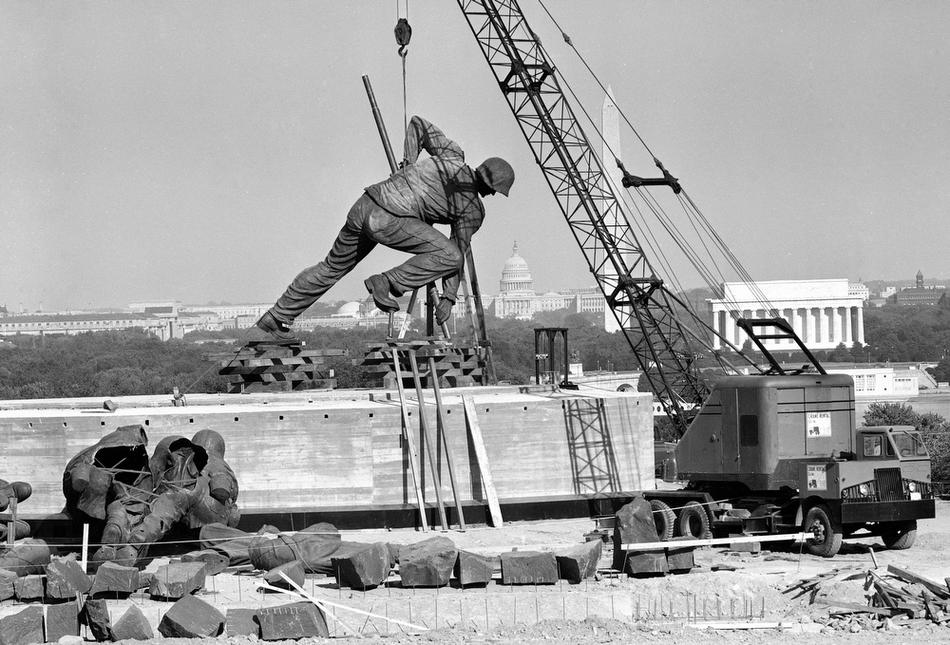
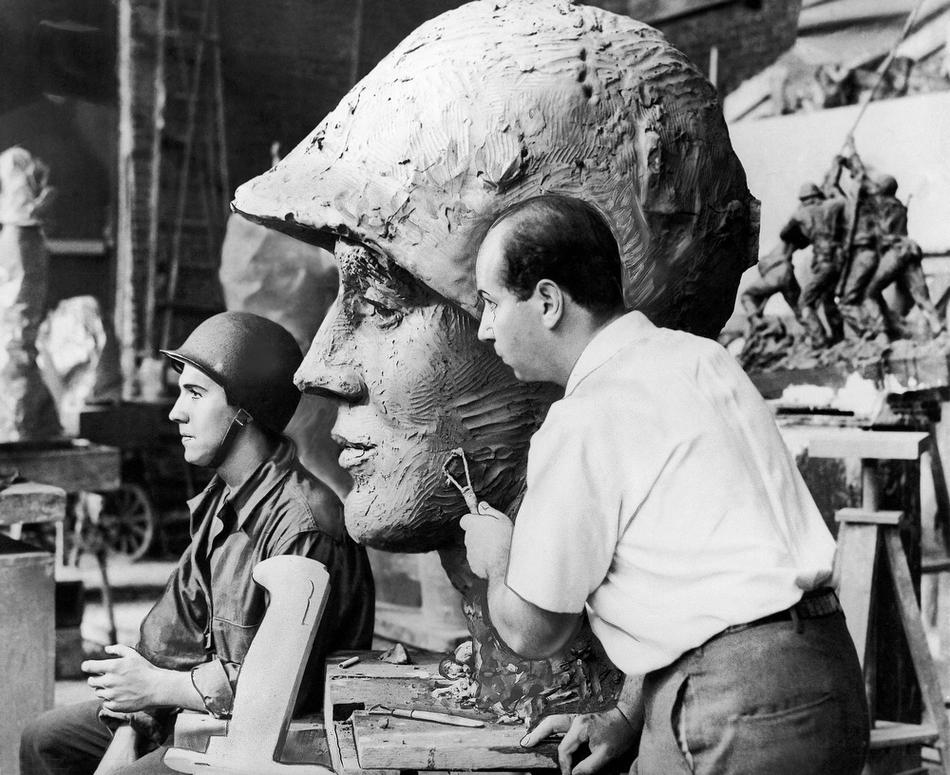
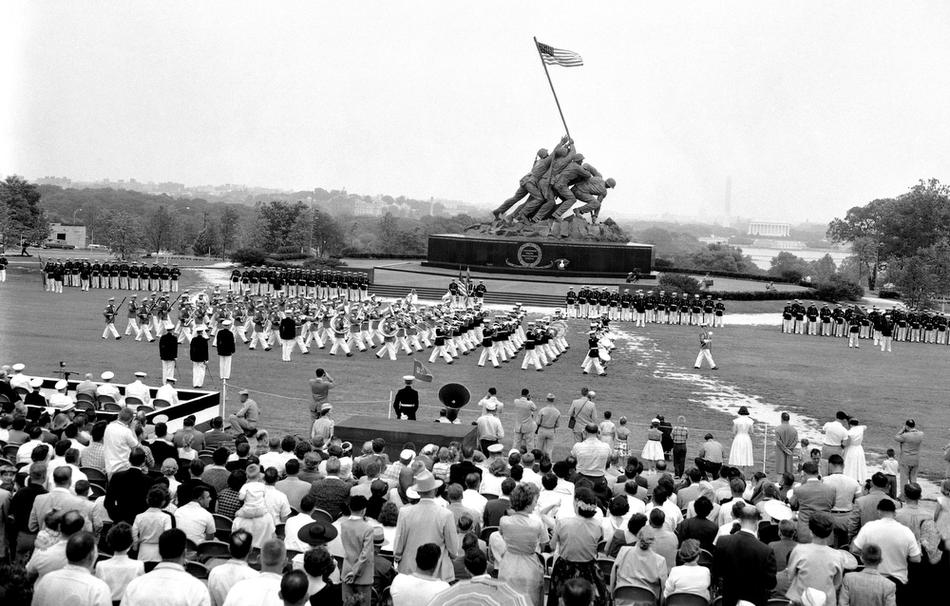
Assembly work started Sept. 13, 1954 on the huge Iwo Jima monument, depicting the raising of the flag on Mt. Suribachi, on a Virginia bluff overlooking the Potomac River across from the nation's Capital. The heavy bronze statue, based on the celebrated photograph by the AP's Joe Rosenthal, will stand on a bluff near Arlington National Cemetery. (AP Photo/William J. Smith)
The statue has been nine years in the making. It is modeled after the photograph snapped by Joe Rosenthal, then with the Associated Press, on the morning of Feb. 23, 1945. Rosenthal was in the Pacific an assignment with the wartime picture pool. Almost immediately upon release of the picture which soon won world wide fame, Feliz De Welden, an internationally known sculptor on duty with the Navy, constructed a scale model of the scene. A life-sized plaster model followed. Heroic sized heads of the six Marines who participated in the flag-raising were then modeled in clay, over steel framework. Legs, arms, hands and shoes, in plaster, were added. The completed plaster model of the entire group in heroic size was cut into 108 pieces, then cast in bronze and welded together at the Bedi-Rassy Art Foundry in Brooklyn. Three trucks were needed to haul the statue to Washington for final assembling. Various stages in the making of the giant memorial are pictured on Oct. 9, 1954. (AP Photo)
The Marine Band parades past the Marine Corps War Memorial -- a study in bronze of the Iwo Jima Flag raising on during a memorial to Marine dead in connection with a reunion of Veterans of four Marine divisions. The Marine Corps War Memorial is seen in Arlington, Va. Joe Rosenthal, The Associated Press photographer who won a Pulitzer Prize for his immortal image of World War II servicemen raising an American flag over battle-scarred Iwo Jima. Rosenthal's iconic photo, shot on Feb. 23, 1945, became the model for the Iwo Jima Memorial near Arlington National Cemetery in Virginia. (AP Photo/Harvey Gorry)
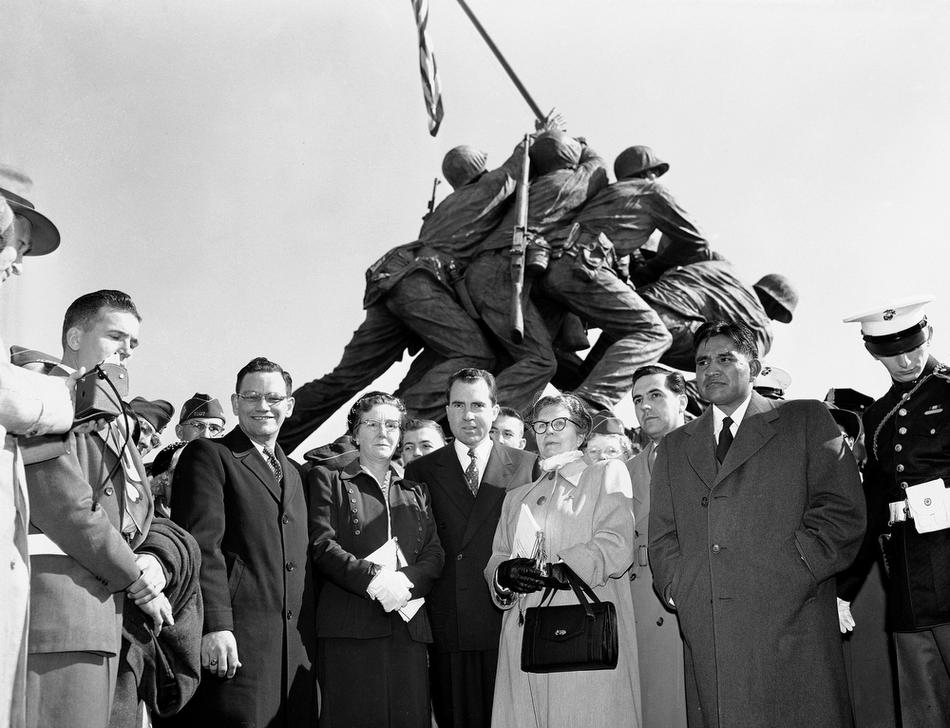
Mothers of two Marines who lost their lives after helping to raise the flag on Mt. Suribachi pose with three survivors and Vice President Nixon in front of the Iwo Jima monument, Nov. 10, 1954 at the dedication ceremony in Washington. From left to right: John H. Bradley of Wisconsin; Goldie Price of Kentucky, mother of the late Pfc. Franklin R. Sousley; Nixon; Belle Block of Texas, mother of the late Cpl. Harlon H. Block; Pfc. Rene A. Gagnon of New Hampshire; and Pfc. Ira Hayes of Arizona. (AP Photo)
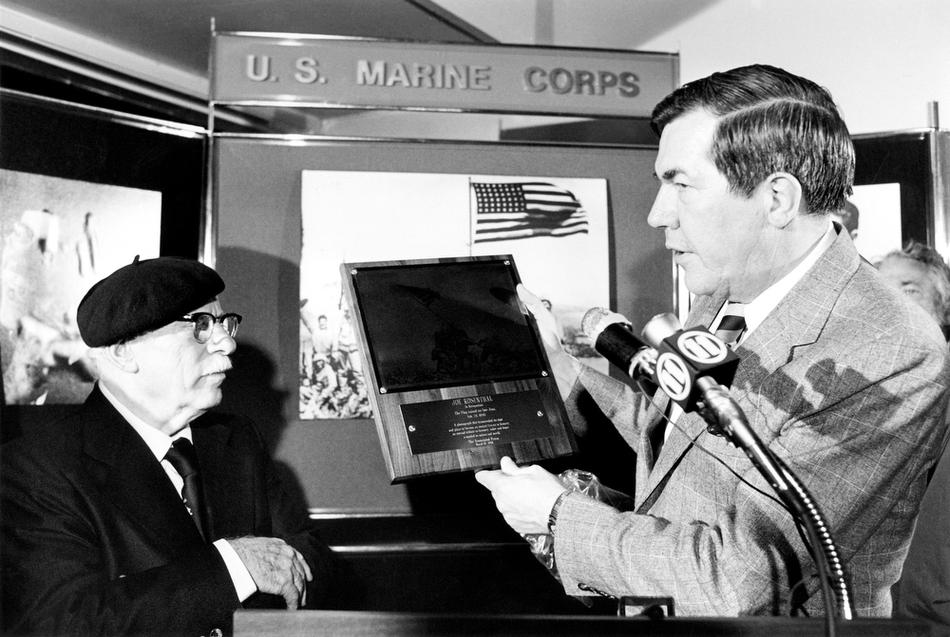
Hal Buell of the Associated Press presents AP award to pulitzer prize winning photographer Joe Rosenthal on his retirment at Treasure Island Naval Base, San Francisco, Calif., March 24, 1981. (AP Photo)
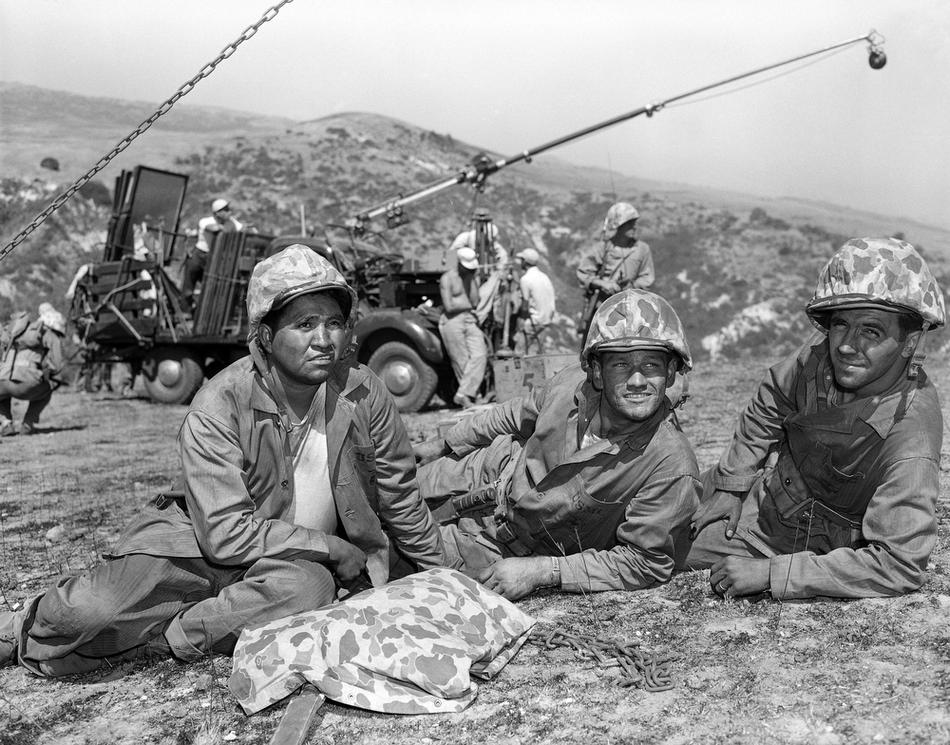
The three survivors of six men who raised that historic flag on Mt. Suribachi, on the island of Iwo Jima, are back in Marine uniforms as they make a Hollywood version of the bloody invasion at Camp Pendleton, Calif., July 27, 1949. Here with sound trucks in the background they watch the filming of a scene. The survivors are: left to right, Ira H. Hayes of Babchule, Ariz.; John Bradley of Antigo, Wisc. and Rene Gagnon of Manchester, N.H.. All three have small parts in the film, including a recreation of the flag raising. (AP Photo/Frank Filan)
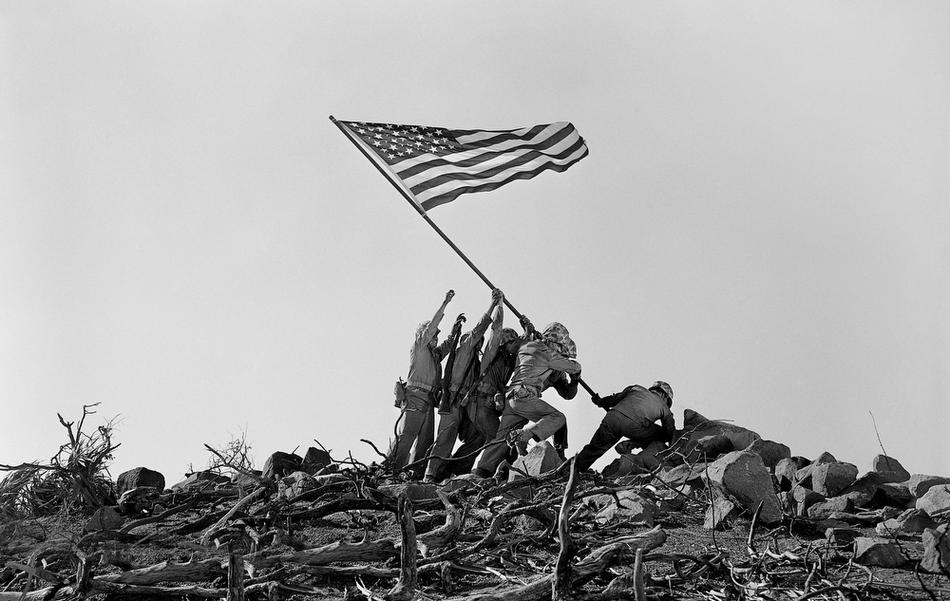
Six "Marines," including three of the original sextet, recreate the memorable flag-raising on Mt. Suribachi for a Hollywood motion picture version of the Iwo Jima invasion at Camp Pendleton, Calif., July 27, 1949. Assuming the positions they had in the iconic photograph, taken by Associated Press photographer Joe Rosenthal, are: Ira H. Hayes; John Bradley and Rene Gagnon. (AP Photo/Frank Filan)
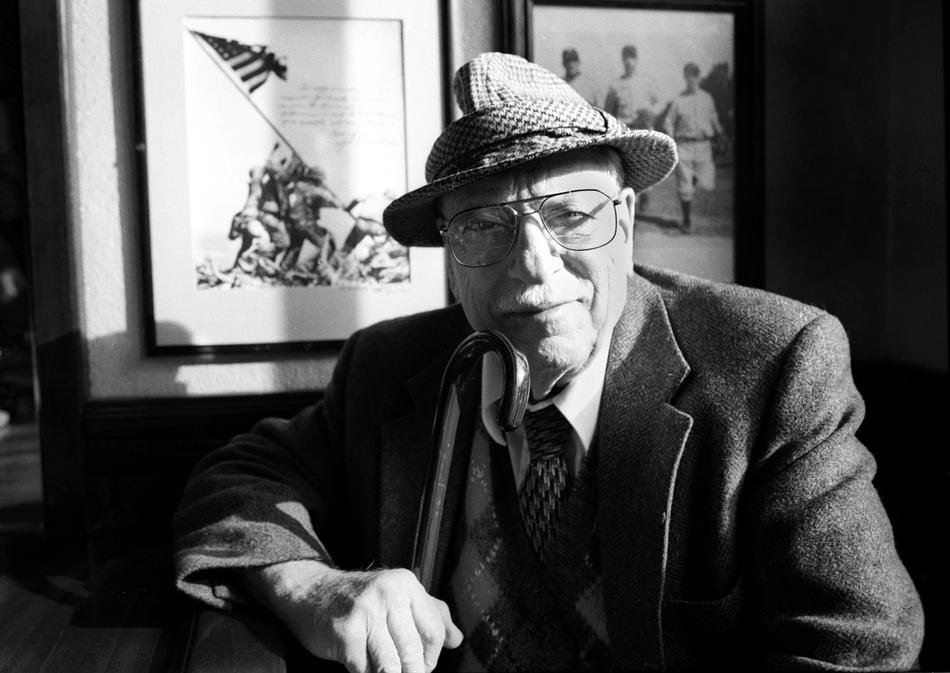
Photographer Joe Rosenthal poses for a photo at the New Pisa Bar and restaurant Monday, Dec. 20, 1994, in San Francisco. Rosenthal, the photojournalist whose Pulitzer Prize-winning image of World War II servicemen raising an American flag over Iwo Jima became the model for the Marine Corps War Memorial, has died. He was 94. Rosenthal, who took the iconic photograph on Feb. 23, 1945 while working for The Associated Press, died Sunday, Aug. 20, 2006, of natural causes at an assisted living facility in suburban Novato, Calif., said his daughter, Anne Rosenthal. (AP Photo/Eric Risberg)
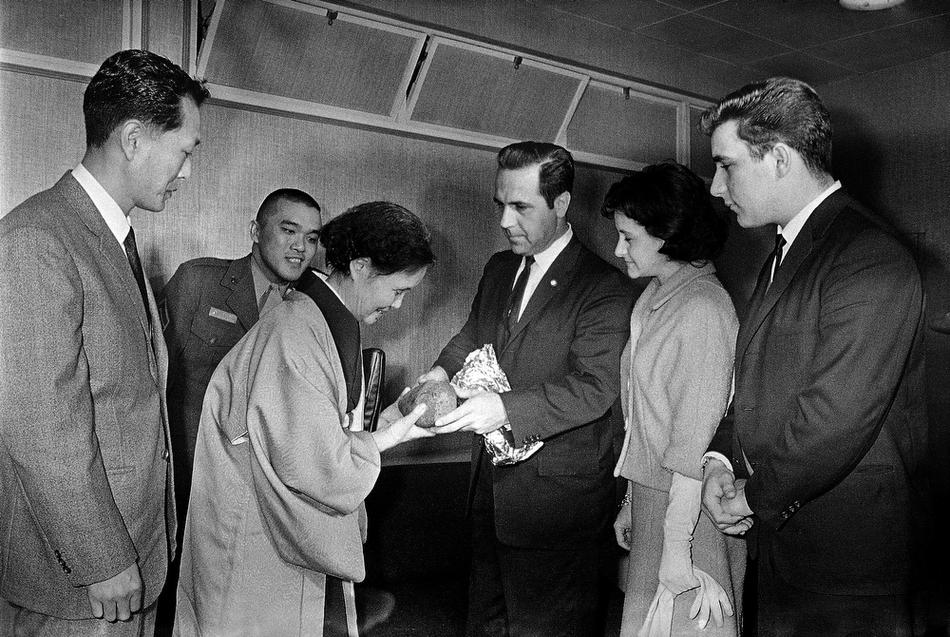
Rene Gagnon hands a stone from Mt. Suribachi on Iwo Jima to widow of Japanese Lt. Gen. Tadamichi Kuribayashi, in Tokyo, Japan, Feb. 25, 1965. Lt. Gen. Kuribayashi committed suicide on the Island after the Japanese were defeated at Iwo Jima. Gagnon was one of six U.S. Marines in AP flag-raising picture on the Pacific Island. From left at presentation in Tokyo are: Taro Kuribayashi, the general's son; a marine interpreter; Mrs. Yoshii Kuribayashi, Gagnon; his wife, and Rene Gagnon, Jr. (AP Photo/Nobuyuki Masaki)
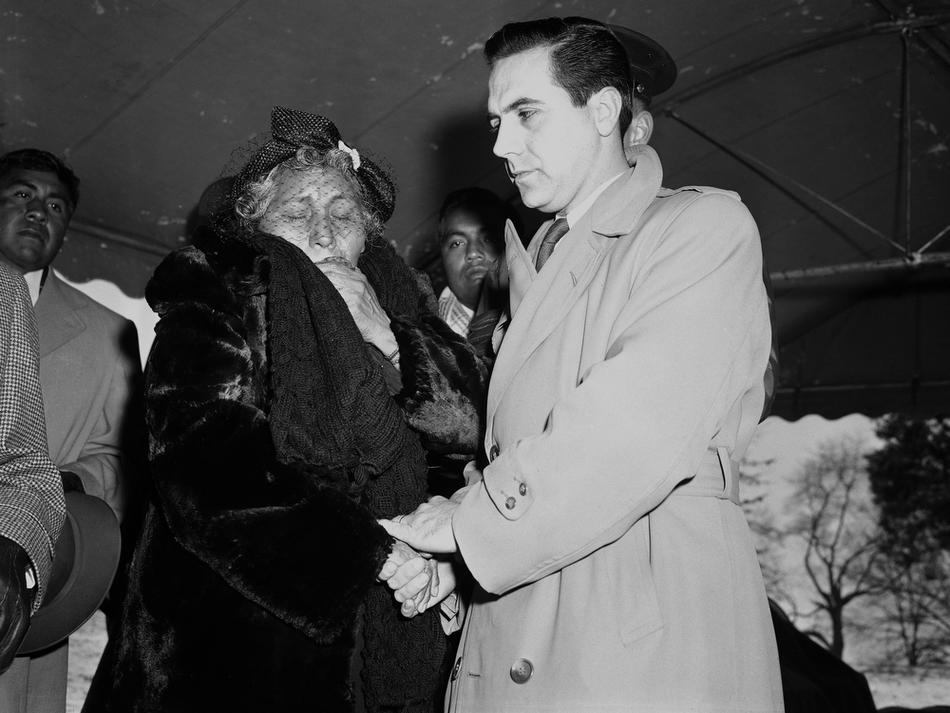
Rene Gagnon comforts Nancy Hayes after the burial of her son Ira, one of the Iwo Jima flag-raisers, in Arlington National Cemetery, Feb. 2, 1955. Gagnon and Hayes were among six Marines who raised the flag atop Mt. Suribachi in 1945. Hayes, a Pima Indian, died of exposure last week on the reservation where he lived in Arizona. (AP Photo/Charles Gorry)
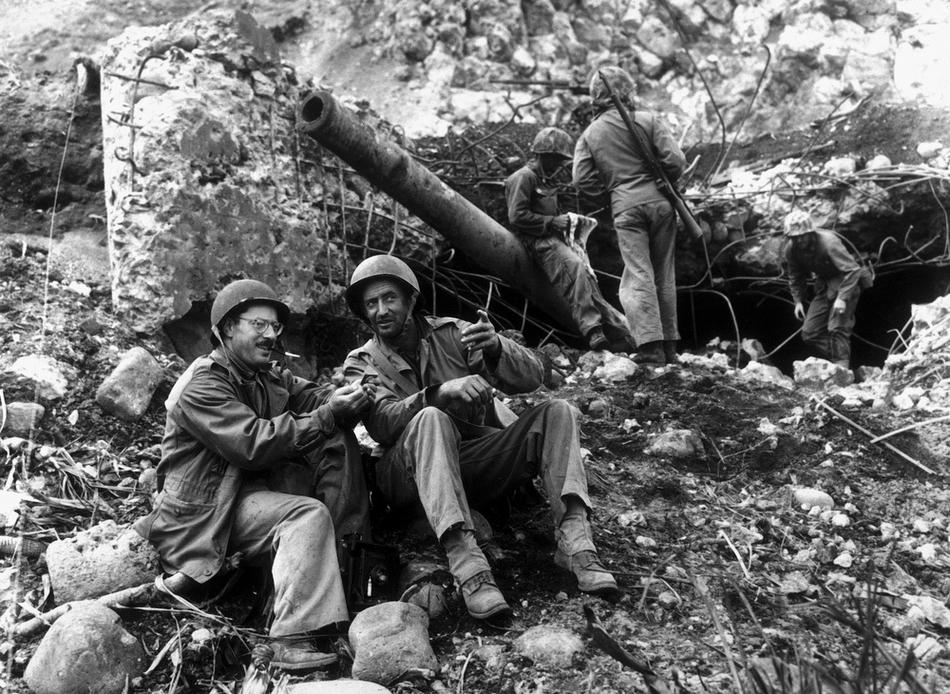
Joe Rosenthal, left, AP photographer with the wartime pool, takes time out to rest, March 2, 1945, with Bob Campbell, a Marine from San Francisco, in front of a large Japanese gun knocked out by Marines at the base of Mt. Suribachi. Rosenthal scaled the mountain to make the picture of the U.S. flag being raised there. Rosenthal, who won a Pulitzer Prize for his immortal image of six World War II servicemen raising an American flag over battle-scarred Iwo Jima. (AP Photo)
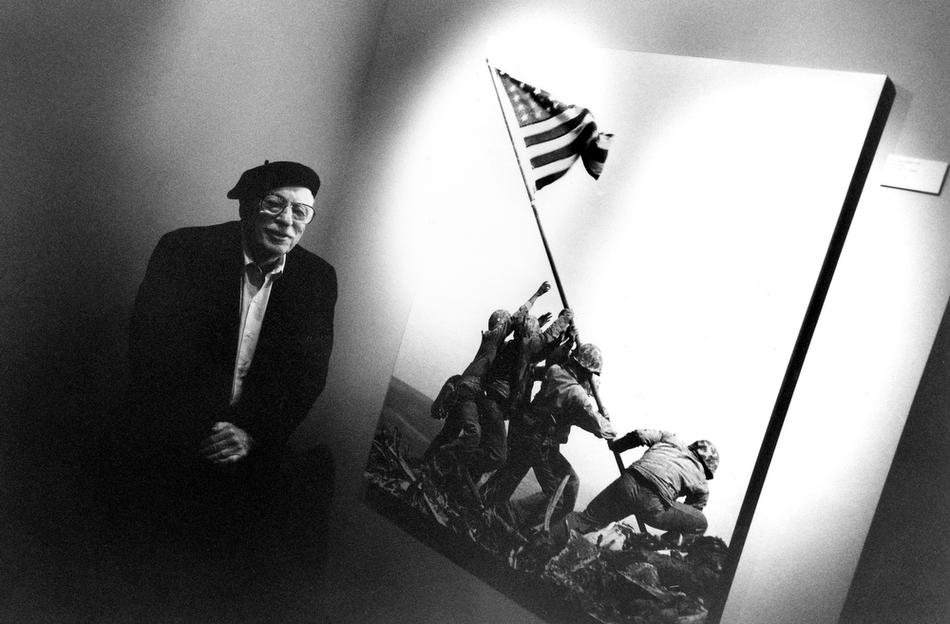
During a visit to AP's New York headquarters in 2003, former AP photographer Joe Rosenthal poses with his Pulitzer Prize-winning photo of the second flag raising on Mt. Suribachi, Iwo Jima, which took place Feb. 23, 1945. (AP Photo/Chuck Zoeller)
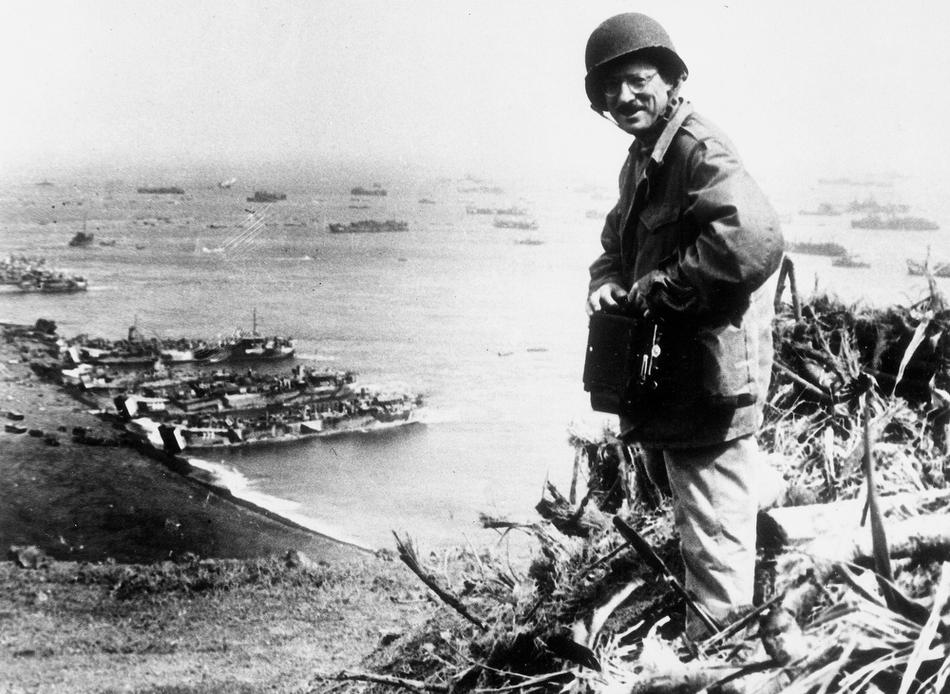
AP photographer Joe Rosenthal, overlooking Iwo Jima in March 1945. (AP Photo/U.S. Marine Corps)
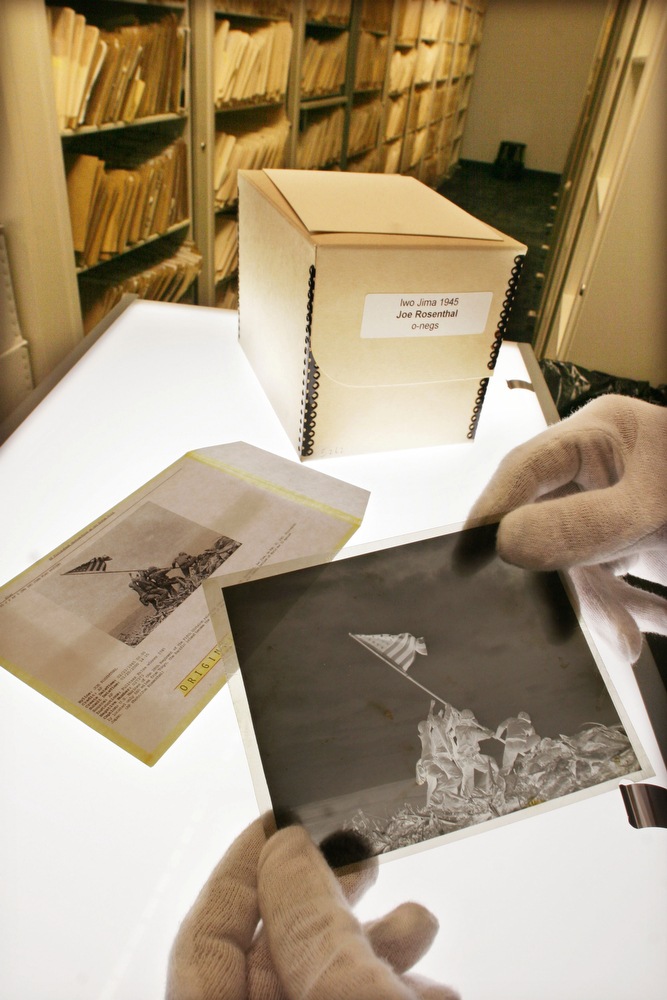
Joe Rosenthal's black and white photo negative of U.S. Marines from the 28th Regiment, 5th Division, raising the American flag atop Mt. Suribachi, Iwo Jima, on Feb. 23, 1945, is handled with gloves by Associated Ppress chief photo librarian Charles Zoeller while being shown from its secured archive at the Associated Press picture library in New York, Monday, Aug. 21, 2006. Rosenthal, an Associated Press photgrapher who won a Pulitzer Prize for the image. (AP Photo/Bebeto Matthews)
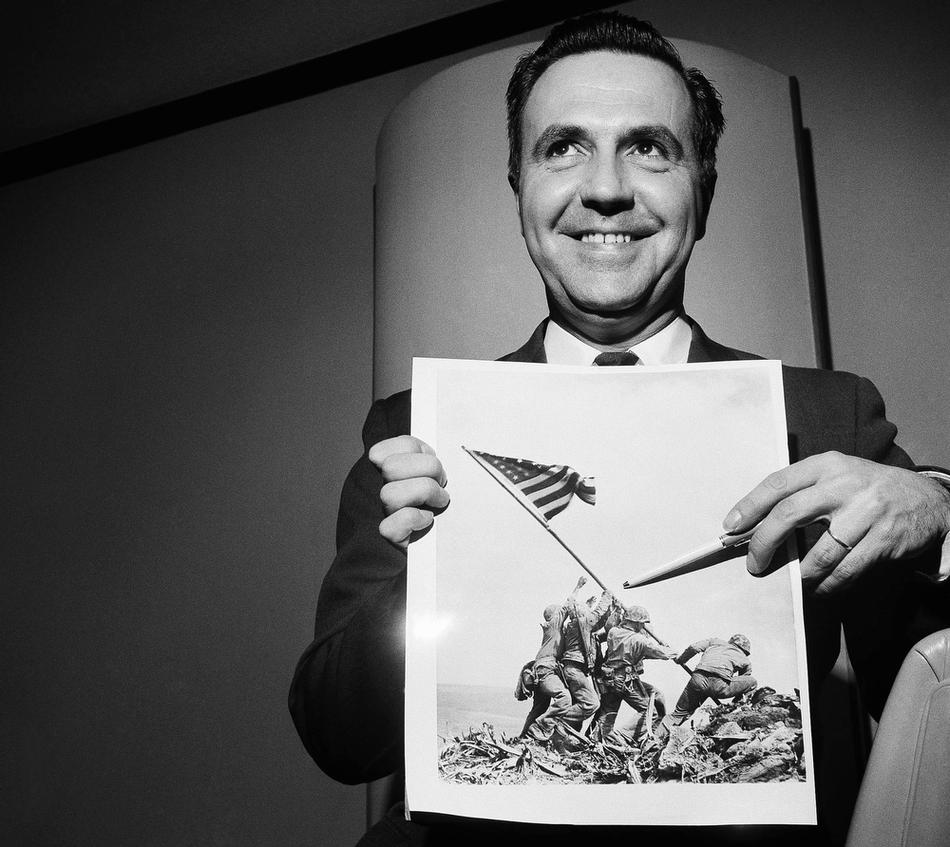
Rene Gagnon, former Marine who participated in the invasion of Iwo Jima, is shown at New York's Kennedy Airport . Gagnon prepares to depart for the orient to attend ceremonies commemorating the 20th anniversary of the landing of the marines on that Pacific Island. The 39-year-old was one of six servicemen who helped raise the American flag on Mt. Suribachi during the Invasion. He is pointing to himself in a historic photograph taken at that solemn moment. (AP Photo)
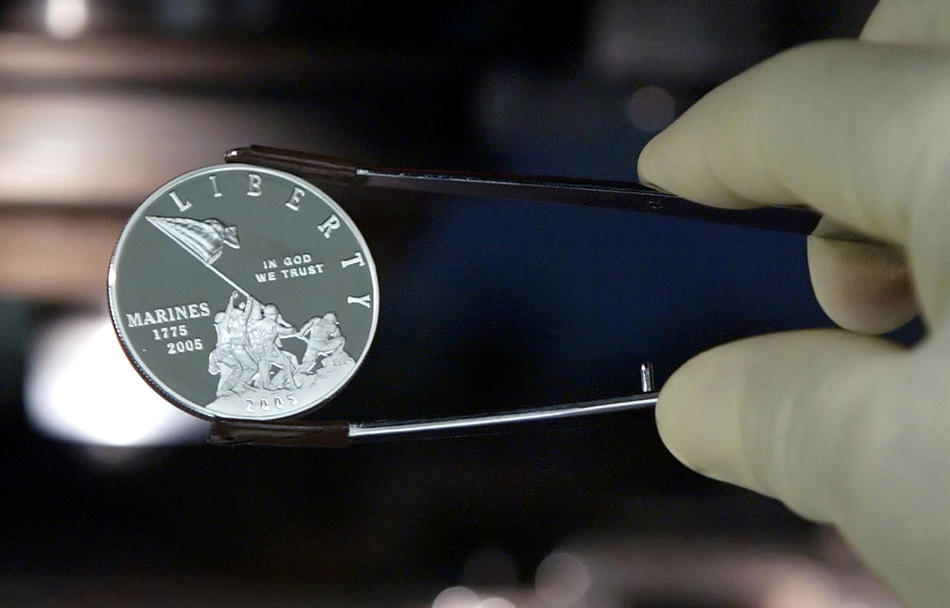
A U.S. Mint employee holds a new coin, Wednesday, May 25, 2005, in Philadelphia, which honors the 230th anniversary of the founding of the Marine Corps, the first time the government has struck a commemorative coin to salute a branch of the military. The new silver dollar will feature the famous photograph of the flag-raising at Iwo Jima taken by Associated Press Photographer Joe Rosenthal, and on the other side the official Marine Corps emblem of an eagle, globe and anchor and the Marine motto, "Semper Fidelis," always faithful. (AP Photo/Joseph Kaczmarek)
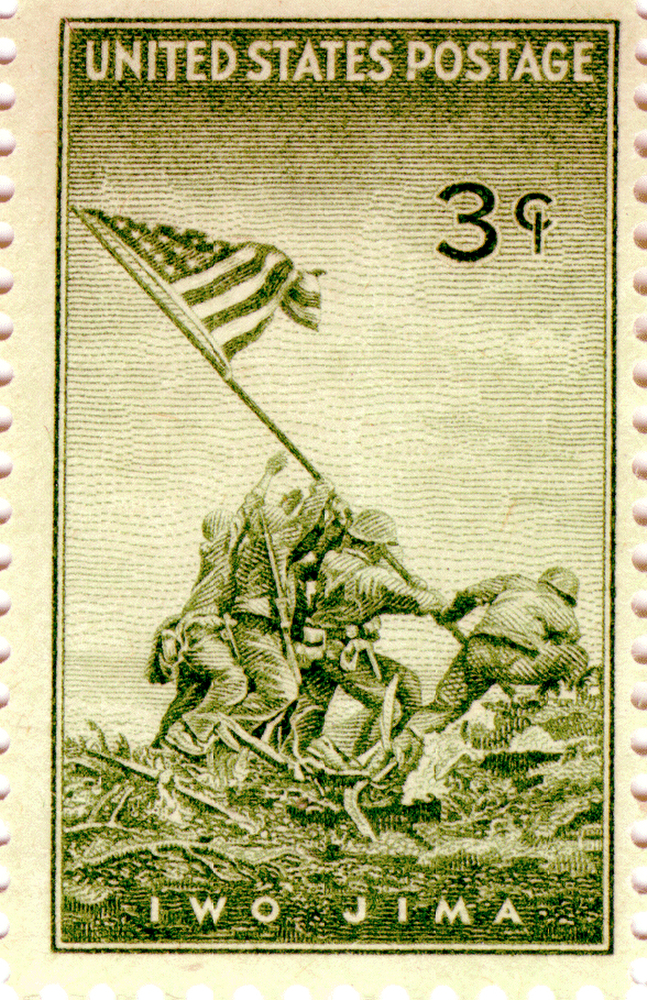
Marines at Iwo Jima 3 cent postage stamp issued Washington, D.C. July 11, 1945, 137,321,000 stamps were sold.
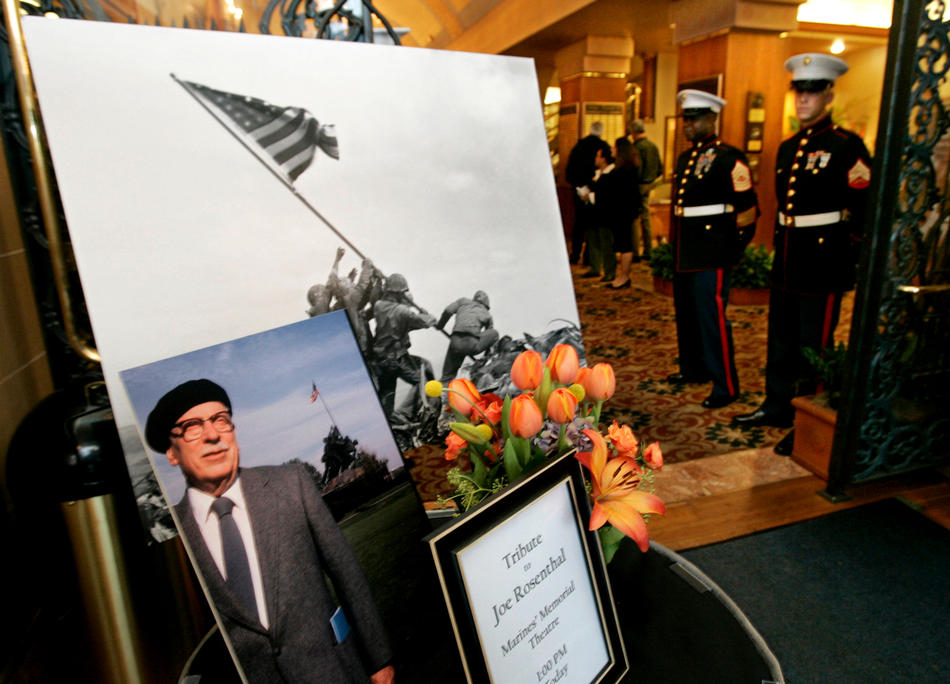
A photo of a former Associated Press photographer Joe Rosenthal and his Pulitzer Prize-winning World War II photograph of the flag raising at Iwo Jima is displayed during a U.S. Marine memorial for Rosenthal in San Francisco, Friday, Sept. 15, 2006. (AP Photo/Paul Sakuma)
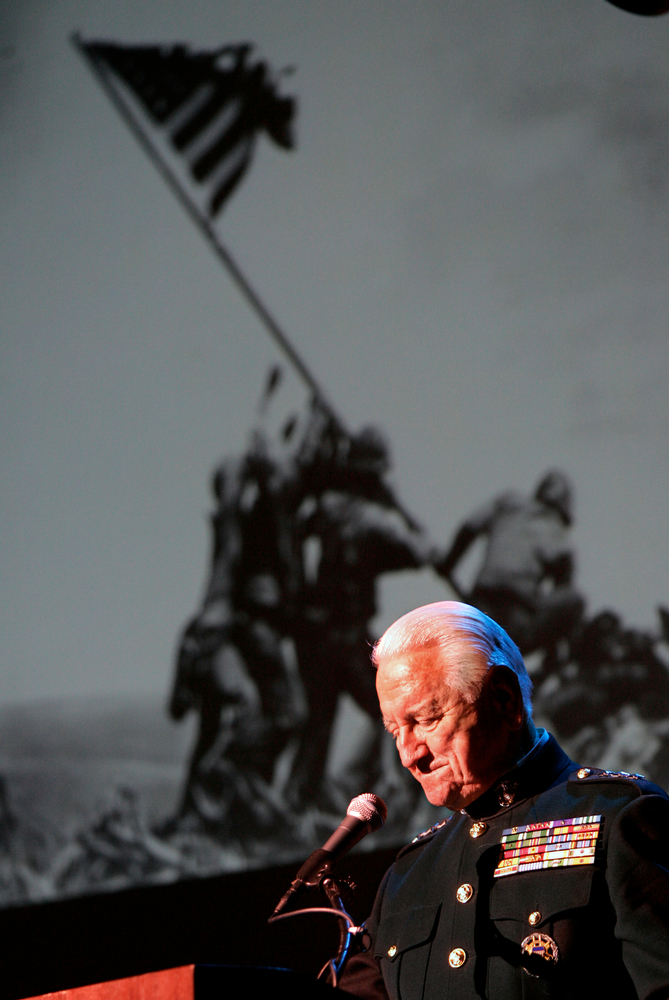
Ret. U.S. Marine Lt. Gen. Larry Snowden speaks during a memorial service for former Associated Press photographer Joe Rosenthal in San Francisco, Friday, Sept. 15, 2006. Rosenthal was awarded the Pulitzer Prize for the photo he took of the Marines raising the flag on Mt Suribachi on Feb. 23, 1945, five days into the battle for Iwo Jima. (AP Photo/Paul Sakuma)
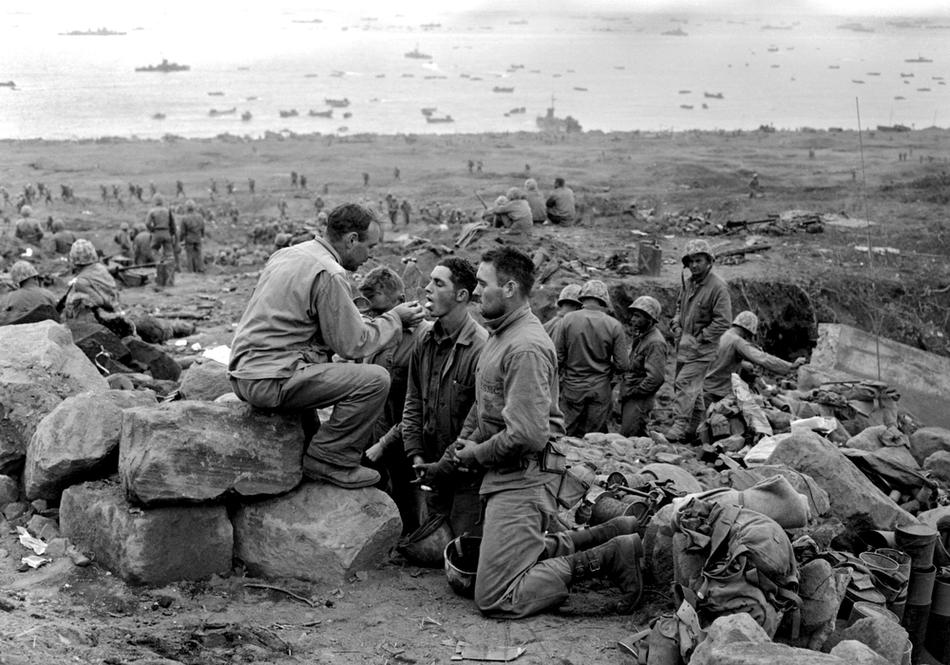
MARCH 3, 1945 U.S. Marines receive Communion from a Marine chaplain on Iwo Jima. The battle for the island was extremely costly for both sides: only about a thousand of the 25,000 Japanese defenders survived; the Americans suffered about 26,000 casualties. The island was not fully secured by the American forces until March 26, but the needed airfields were up and running earlier. (AP Photo/Joe Rosenthal)
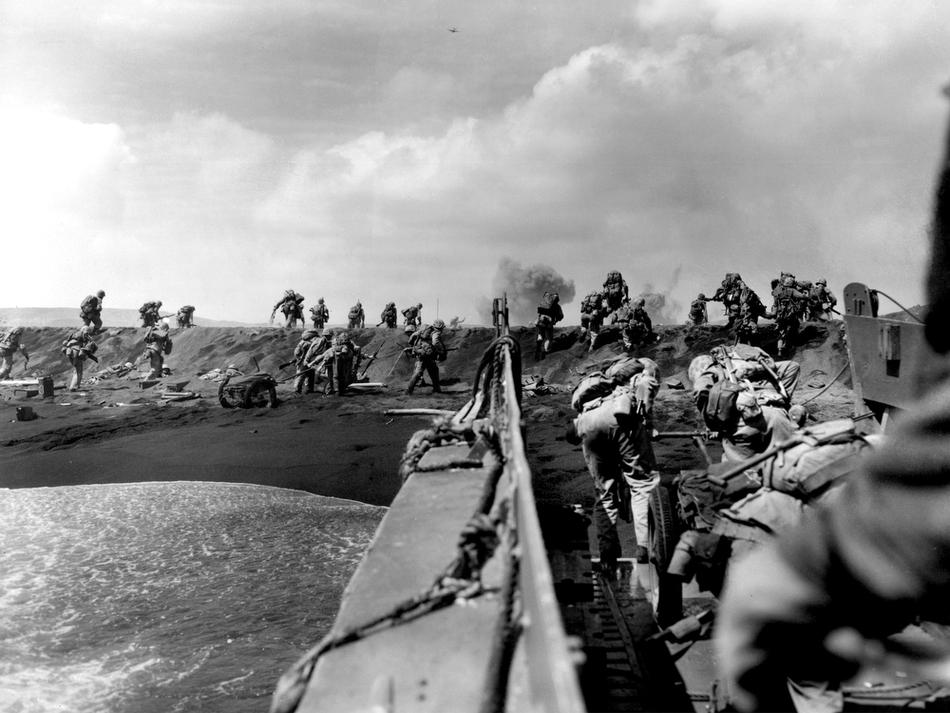
In the Pacific theater of World War II, U.S. Marines hit the beach and charge over a dune on Iwo Jima in the Volcano Islands Feb. 19, 1945, the start of one of the deadliest battles of the war against Japan. (AP Photo/Joe Rosenthal)
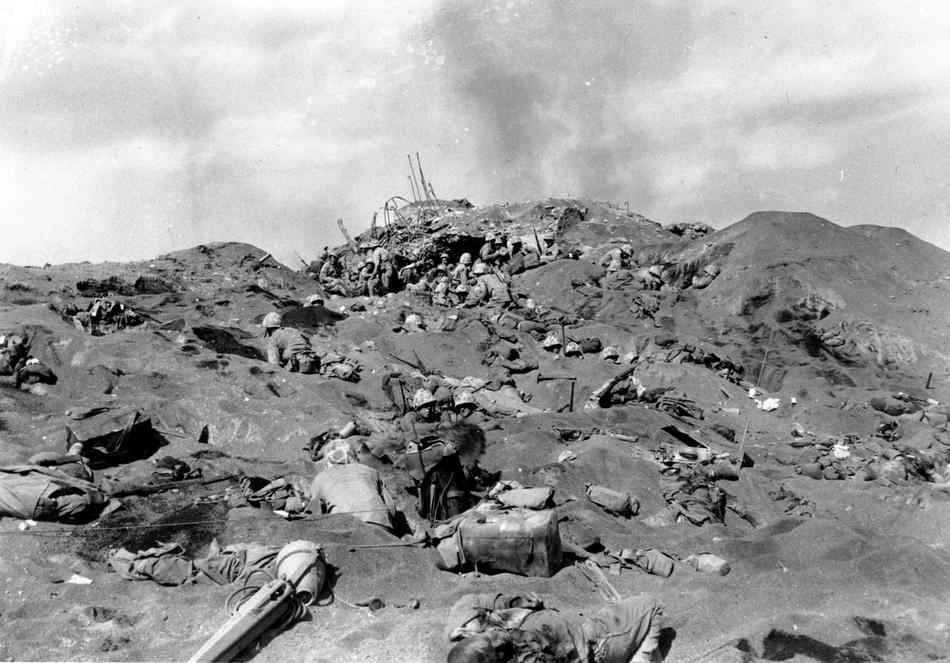
U.S. Marines invade the Japanese stronghold at Iwo Jima, Volcanic Island, on Feb. 19, 1945. The fourth division Marines dig foxholes, center, uncovering dead bodies, and await further orders. The Japanese pillbox-blockhouse, which was considered unconquerable, can be seen at center in the background. (AP Photo/Joe Rosenthal)
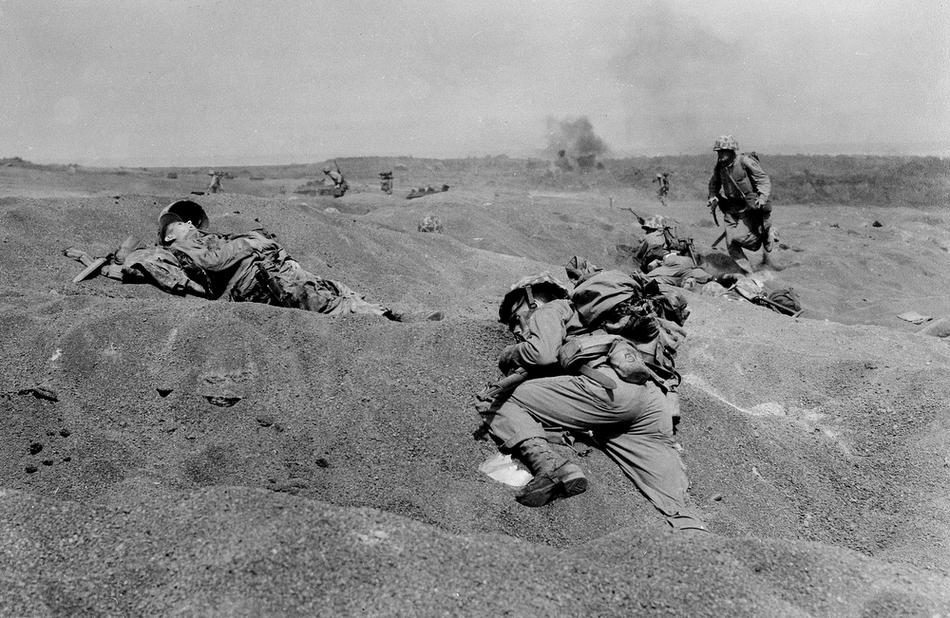
Two U.S. Marines, slumped in death, lie where they fell on Iwo Jima, among the first victims of Japanese gunfire as the American conquest of the strategic Japanese Volcano Island begins on Feb. 19, 1945 during World War II. (AP Photo/Joe Rosenthal)
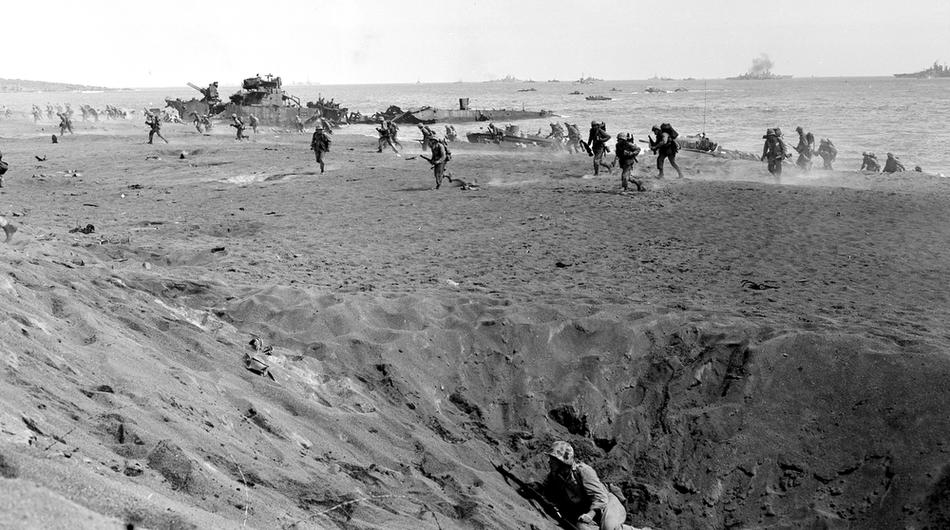
U.S. Marines of the 4th Division charge ashore at the start of the Iwo Jima invasion, as they run for cover in shell holes and bomb craters made by pre-invasion bombardments, on Feb. 25, 1945 during World War II. Warships offshore give heavy gun support. At center in the background is a wreckage of a Japanese ship. (AP Photo/Joe Rosenthal)
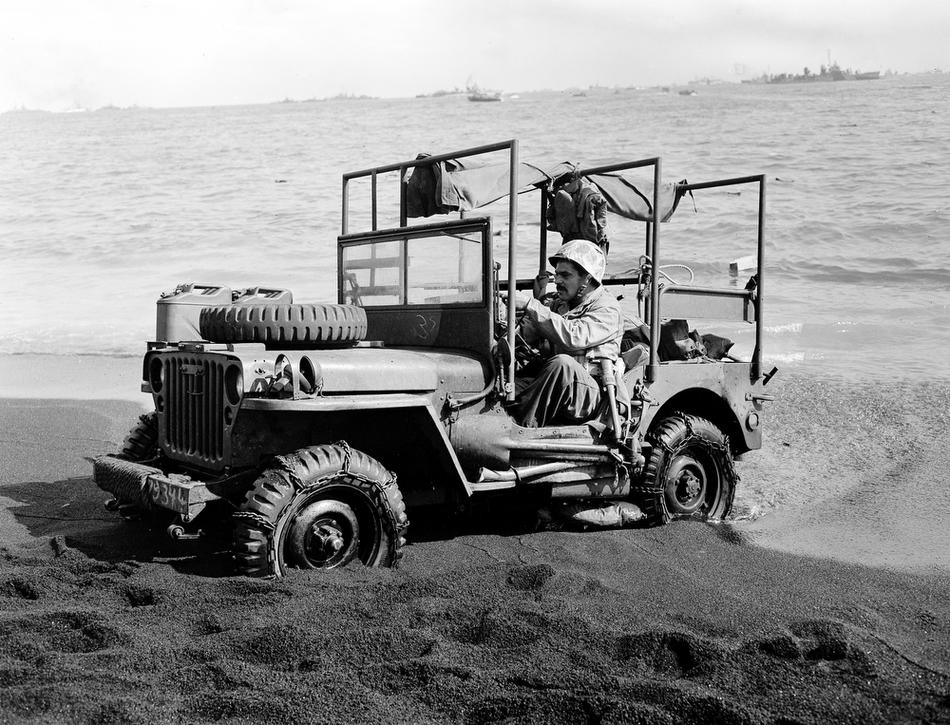
A U.S. Marine driving an ambulance jeep struggles in the sandy beach at Iwo Jima during American advance on the strategic Japanese Volcano Island stronghold on Feb. 26, 1945 in World War II. (AP Photo/Joe Rosenthal)
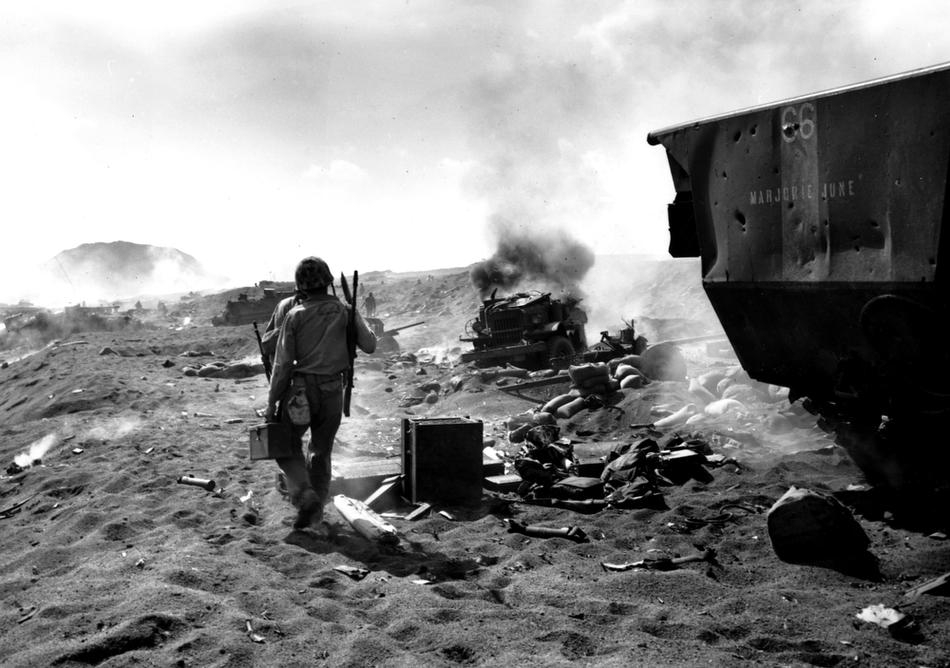
U.S. GI's inspect the remains of an ammunition truck hit by Japanese fire on the beach at Iwo Jima on Feb. 13, 1945 during World War II. (AP Photo/Joe Rosenthal)
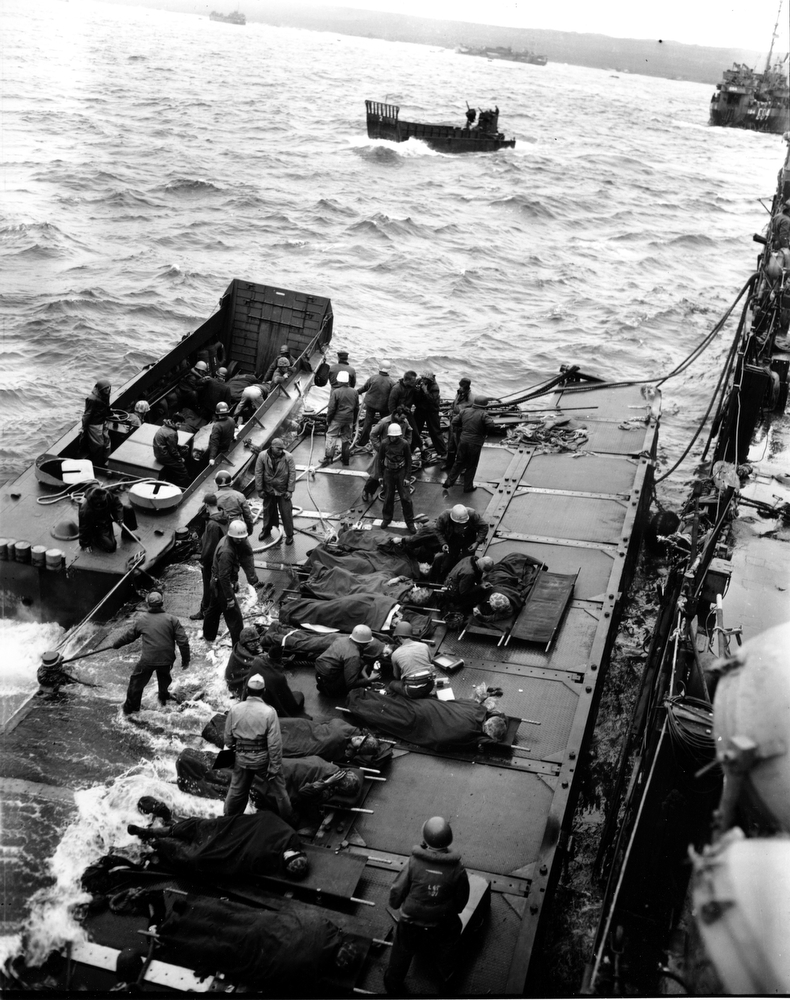
U.S. Marines wounded at the beach of Iwo Jima are evacuated on pontoon barges by hospital corpsmen on Feb. 27, 1945. They will be taken to an LST standing by for transfer to hospital ships. (AP Photo/Joe Rosenthal)
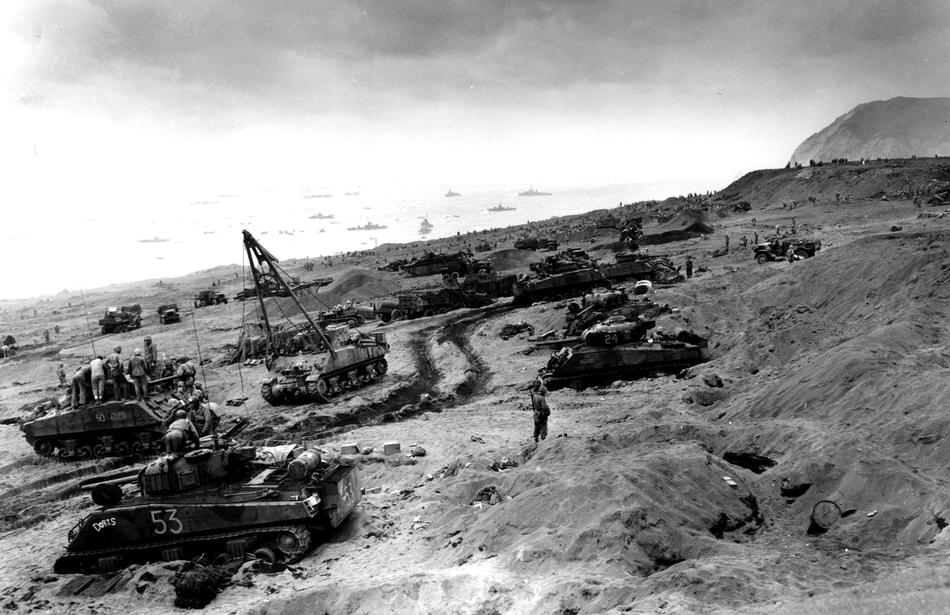
With the capture of the elevated Japanese airstrip, at top right, American equipment and supplies are brought ashore on Feb. 28, 1945. U.S. Marines move forward with tanks and continue the invasion battle inland on Iwo Jima during World War II. Mt. Suribachi Yama can be seen beyond the airstrip. (AP Photo/Joe Rosenthal)
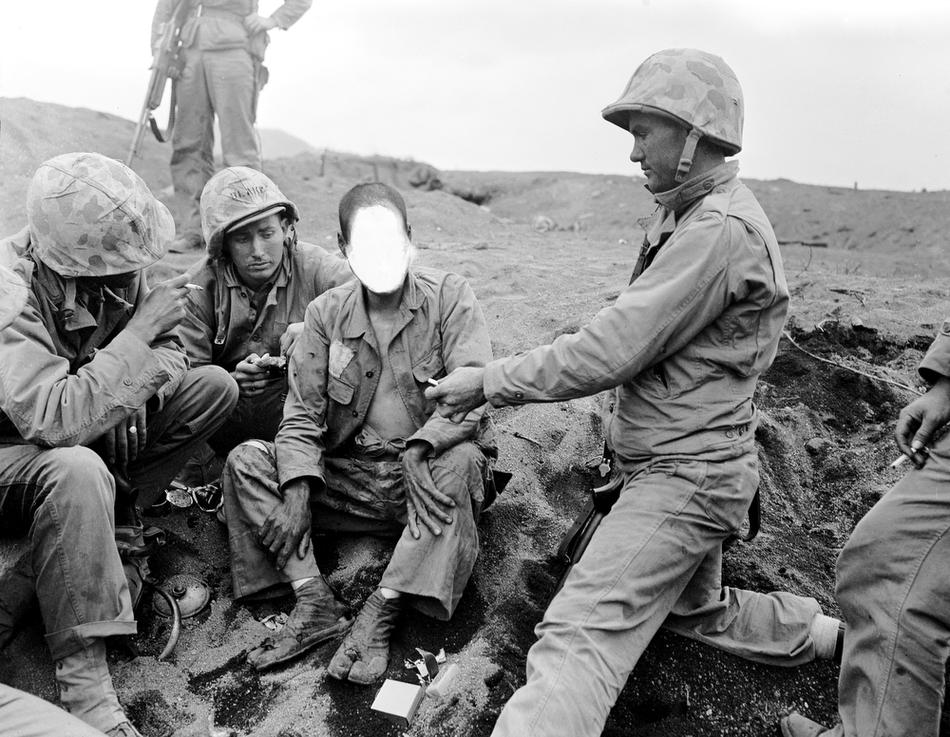
U.S. Marines offer a Japanese prisoner of war, whose face is obliterated by censors, after he is captured during American invasion of Iwo Jima, Japanese Volcano Island stronghold, on Feb. 28, 1945 in World War II. (AP Photo/Joe Rosenthal)
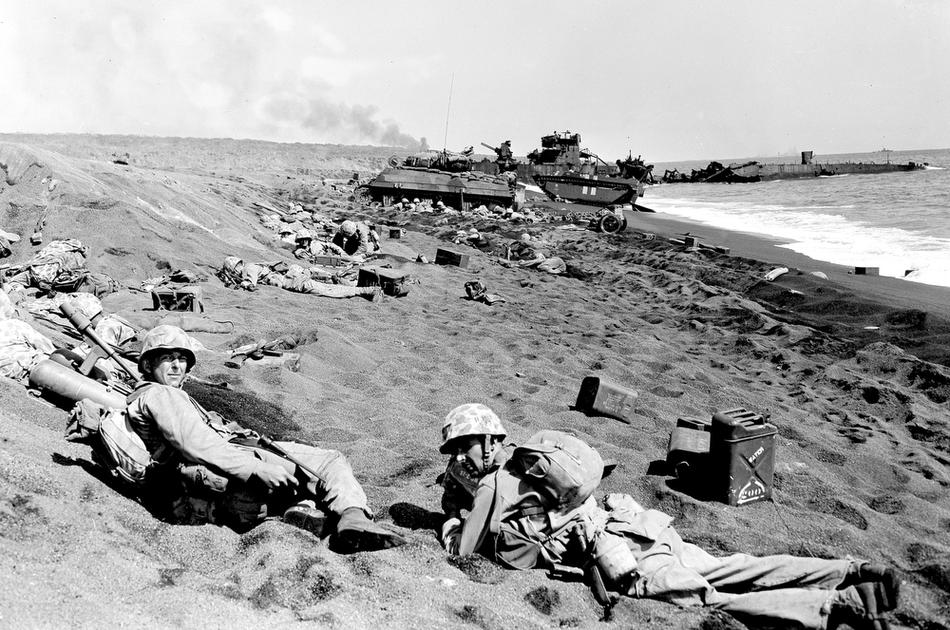
U.S. Marines of the Fourth Division shield themselves in abandoned Japanese trench and bomb craters formed during U.S. invasion and amphibious landing at Iwo Jima, Japanese Volcano Island stronghold, on Feb. 19, 1945 in World War II. A battered Japanese ship is at right in the background at right. (AP Photo)
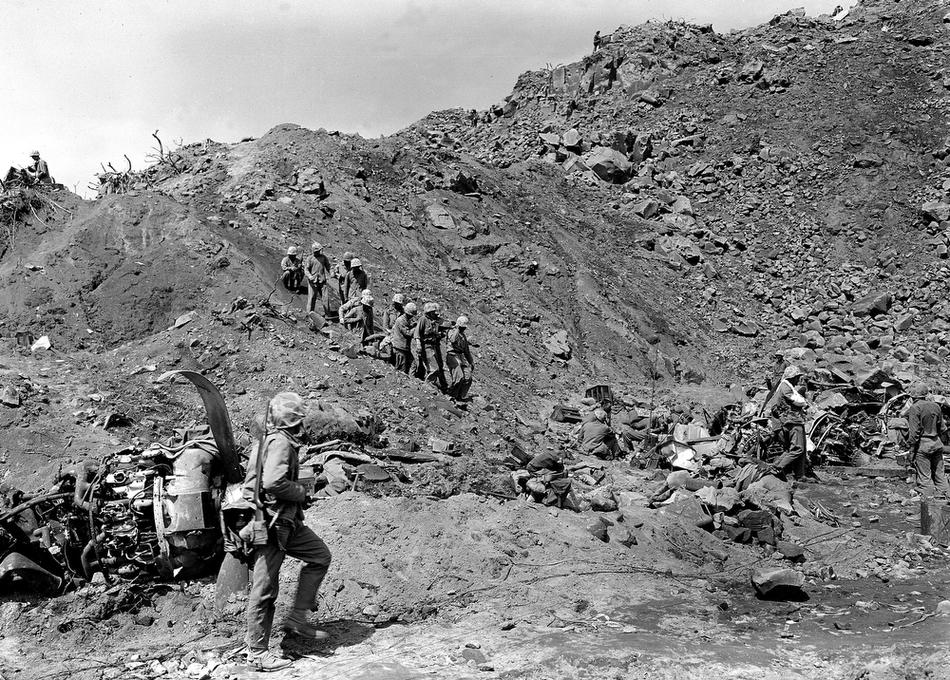
Injured U.S. Marines walk down the hillside as another wounded is carried on a stretcher to a medical station below on Iwo Jima, Japan, on March 2, 1945 during World War II. (AP Photo/Joe Rosenthal)
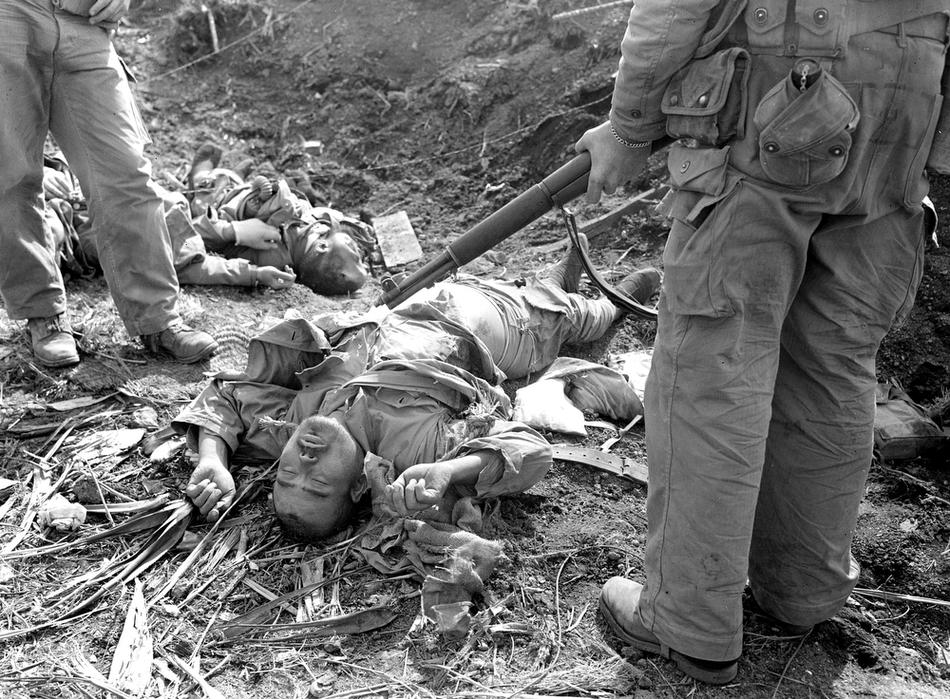
Dead Japanese soldiers who defended the stronghold lie at the feet of U.S. Marines following American invasion of Iwo Jima, Japanese Volcano Island, March 2, 1945 in World War II. (AP Photo/Joe Rosenthal)
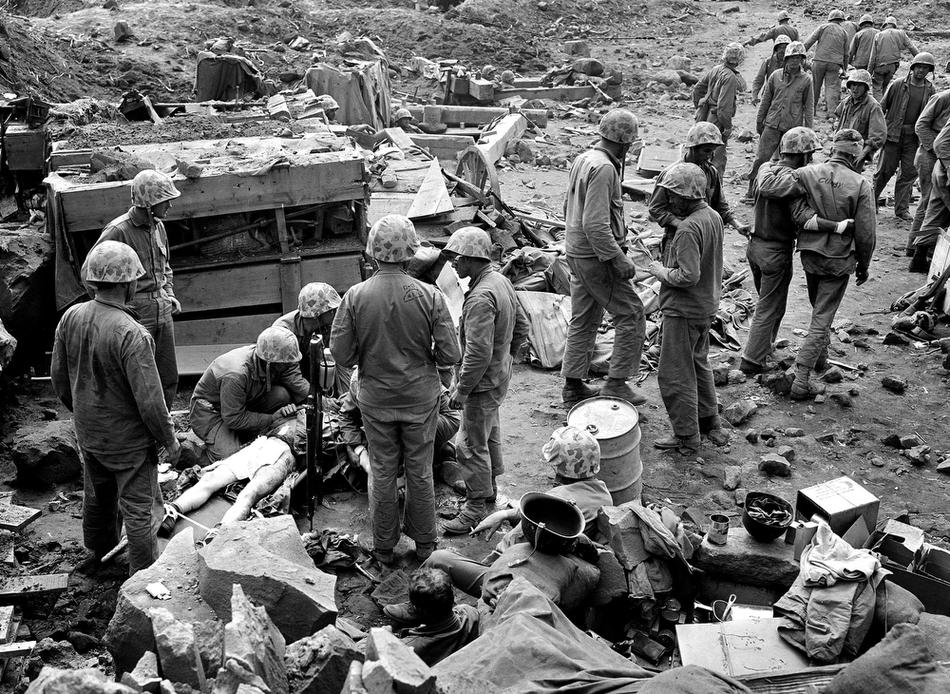
A wounded U.S. Marine soldier, lying on stretcher at left, is given blood plasma by American Navy hospital corpsmen on Iwo Jima, Japan, on March 3, 1945 during World War II. Two Marines can be seen walking away, at right, after getting medical attention. The aid station is surrounded by captured Japanese equipment. (AP Photo/Joe Rosenthal)
Paul Marquis
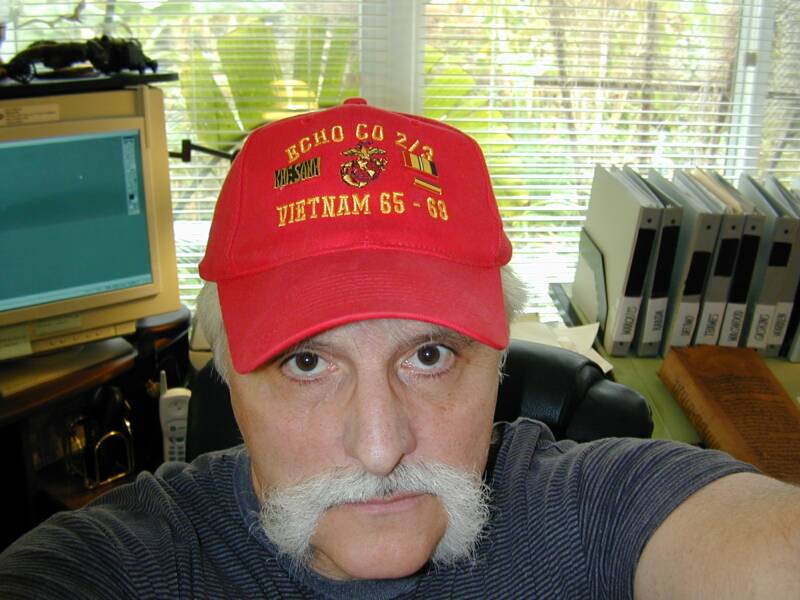
 | ||||||

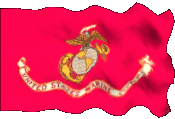
SOUND
CONTROL

